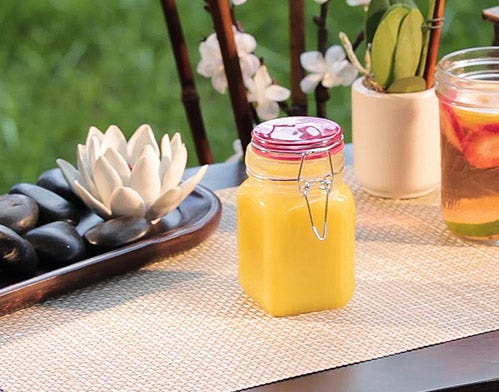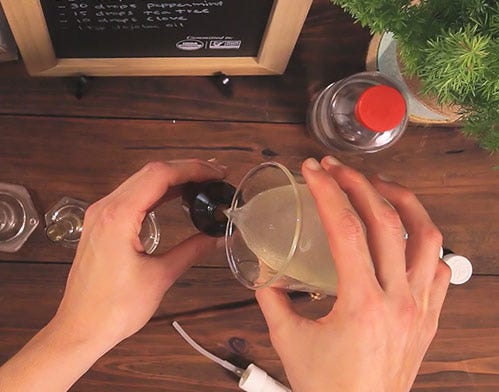DIY Sunscreen
- 8/15/16

Many people don't think about what’s in their personal care items, including cosmetics, but they should because industry estimates and the Campaign for Safe Cosmetics polling and surveys say that consumers use anywhere from 15 to 25 different cosmetic products a day which contain more than 200 different chemical compounds. The term cosmetics, by the way, can include anything from shampoo, conditioner, moisturizers, body lotion, hand lotion, deodorant, hand soap, sunscreen, lip balm and more—so that covers a range of products that can potentially carry a host of chemicals. For example, some of the chemicals found in our personal care products are also used in heavy manufacturing industries to grease gears, stabilize pesticides and to soften plastics.
Of the over 10,000 chemicals used in cosmetics, however, only approximately 11 percent have been assessed for health and safety by the FDA or other government agency. But that’s not all. The Environmental Working Group’s “Skin Deep Database” says that one-third of all personal care products contain at least one chemical linked to cancer.
Here’s a look at some—but certainly not all—chemicals to look out for and to avoid:
Phthalates, chemicals commonly used in nail polishes and to fragrance personal care products, have been shown to cause birth defects in animals. Tests in the United States indicate that phthalates are being retained in human tissue at much higher levels than was previously believed.
Sodium lauryl sulfate (SLS) is a surfactant used extensively in shampoos, soaps, toothpastes and many other beauty and personal care products. SLS can irritate skin for up to a week, while damaging skin proteins and healthy skin oils. Likewise, it causes free radicals and inflammation.
Parabens are chemicals used in makeup, moisturizers, shampoos, shaving gels and more. They are implicated in increasing the risk of breast cancer and in male reproductive problems. When exposed to sunlight, parabens may also help set the stage for skin cancer.
Propylene glycol (PG) is used in anti-freeze and degreasing agents as well as in over 4,000 skin care products and cosmetics—in a supposedly “safe” form. The Environmental Working Group, however, cautions consumers that it is linked to cancer, toxicity and allergies. PG is also associated with skin irritations, including contact dermatitis and urticaria, a condition in which the presence of too many mast cells are in the skin.
Toxic preservatives—including compounds that release formaldehyde, a probable carcinogen—are used to prolong the shelf lives of many personal care products. One of these, DEA (diethanolamine), can cause eye and skin irritations and, at high doses, has been implicated in liver cancers and precancerous changes in the skin and thyroid. Dermatologists rank preservatives as the second most likely category of ingredients to cause skin reactions.
Certain coloring agents and dyes used in cosmetics are common allergens and irritants, while others contain lead acetate, a heavy metal that is toxic to the nervous system.
Triclosan, a popular, but not essential, ingredient is used in many antibacterial soaps and other personal care items, such as deodorants and mouthwashes. A study published in the Proceedings of the National Academy of Sciences says that triclosan—at relatively low concentrations—is linked to muscle function impairments in humans in a relatively quick timeframe. The chemical reduces contractions in cardiac and skeletal muscles, which has the potential to contribute to heart disease and heart failure.
Those are just a few of the chemicals and toxins—beauty's beasts—to avoid in your personal care products. Instead, choose products that are chemical and toxin free.
You can also make your own sunscreen using organic ingredients, such as this DIY Sunscreen recipe from our very own Chef Gwen!
DIY Sunscreen
You will need:
1 large jar
1 pan
1 small Mason jar
1 wooden spoon
Organic Ingredients: ½ cup olive oil
¼ cup coconut oil
¼ cup beeswax pellets (also known as pastilles)
2 Tablespoons zinc oxide (powder form)
2 Tablespoons shea butter
2 teaspoons carrot seed oil
1 teaspoon essential oil, such as citrus or coconut
Directions:Fill pan with about two inches of water, and heat to medium heat. Place the large glass jar into the pan, and add all ingredients except the zinc oxide powder. Allow ingredients to melt together, stirring occasionally (this will take about 10 minutes). Turn off heat and add in zinc oxide, being careful to not inhale the zinc oxide. Stir again, and then let cool. Pour into a small Mason jar, and store in a dark, cool cabinet. Use sunscreen for SPF protection of 20. Reapply occasionally, if you are swimming. Best if used within six months.




